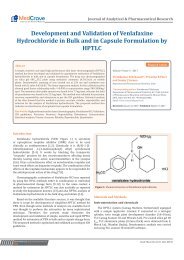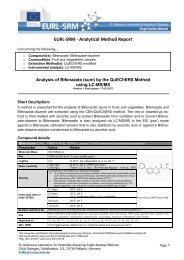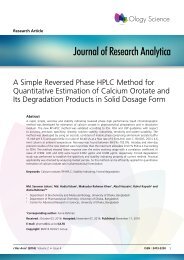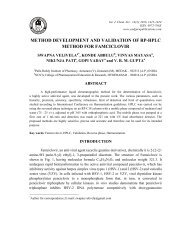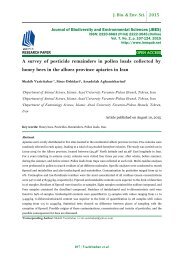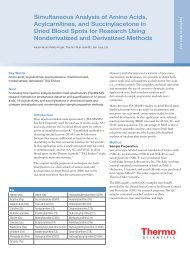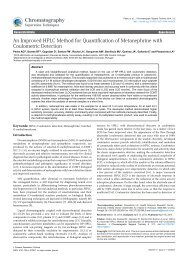acta 2_2015
acta 2_2015
acta 2_2015
- No tags were found...
You also want an ePaper? Increase the reach of your titles
YUMPU automatically turns print PDFs into web optimized ePapers that Google loves.
Acta Poloniae Pharmaceutica ñ Drug Research, Vol. 72 No. 2 pp. 235ñ244, <strong>2015</strong> ISSN 0001-6837Polish Pharmaceutical SocietyLIPOPHILICITY ASSESSMENT OF SPIRONOLACTONE BY MEANSOF REVERSED PHASE LIQUID CHROMATOGRAPHY AND BY NEWLYDEVELOPED CALCULATION PROCEDURESMA£GORZATA DO£OWY* and ALINA PYKAMedical University of Silesia in Katowice, School of Pharmacy and the Division of Laboratory Medicine,Department of General and Analytical Chemistry, Institute of Analytical Chemistry,4 JagielloÒska St., 41-200 Sosnowiec, PolandAbstract: The parameters of lipophilicity of spironolactone (a single member of steroids group), which is widelyapplied as diuretic and antihypertensive agent, were experimentally determined by reversed-phase TLC andHPLC methods as well as calculated using different computer programs and also by a novel mode based ontopological indices. Various stationary phases, such as RP-18WF 254 , RP-2F 254 , RP-18F 254 and also differentbinary solvent systems composed of organic modifier (e.g., methanol, dioxane, acetone) and water were usedas mobile phases in order to predict the following chromatographic parameters: R MW and logk w , respectively.LogP of examined spironolactone calculated with respective theoretical procedures: AlogPs, logP KOWWIN ,xlogP2, xlogP3, AClogP, AlogP, MlogP and also logP average were obtained from online package software. Thepartition coefficients expressed as logP 1 , logP 2 and logP 3 were calculated by means of the formulae based onthe numerical values of the following topological indices: , 0 B, 1 B, W, 0 χ ν and I B , which was novelty of thisstudy. A good agreement between logP calculated by new method and experimentally estimated lipophilicityparameters (by chromatography and by shake flask method) was found. The results confirmed applicability ofthe topological indices for calculating lipophilicity of spironolactone as alternative procedure to the experimentaland other computed logP values.Keywords: lipophilicity, logP, logk w , R MW , spironolactone, topological indices, RP-TLC, RP-HPLCFor many years, increasing development ofnew biologically active compounds for applicationin medicine as potential drugs is observed. The pharmacokineticprofile of newly discovered drugsdepends on various factors. Among different physicochemicalproperties that has significant impact ondrug behavior in biological system is lipophilicity(hydrophobicity). This property plays decisive rolein drug design, especially in the prediction of transportof biomolecule trough cell membranes in biologicalsystem. The most common lipophilictymeasure is logP (logarithm of partition coefficient)determined by different separation methods includingchromatography. The traditional method whichhas been widely used for the determination oflipophilicty (logP) of organic compounds in n-octanol - water system is the shake flask technique(1). As it is well known, this method is rather timeconsuming and allows to determine logP in limitedrange from -3.0 to +3.0, therefore in order to eliminatethis limitation, the chromatographic methodscan be utilized. Among numerous chromatographicapproaches like reversed phase thin layer chromatography(RP-TLC) or reversed phase high performanceliquid chromatography (RP-HPLC),which can be currently performed in lipophilicityinvestigations with the use of modern mobile andstationary phases, such as immobilized articificialmembranes (IAM), an alternative technique to thosemay be micellar liquid chromatography (MLC) inTLC and HPLC systems. Electrophoretic methodsare suitable for the estimation of the lipophilicity ofvarious biomolecules in the wide range of logP.The most commonly used chromatographiclipophilicity descriptors are: R MW ñ in thin layer chromatographyand also logk w in column chromatography.Analogously to both, the micellar logk m parametercan be evaluated as lipophilicity descriptor.Many researches were applying RP-TLC, RP-HPLCand also MLC in lipophilicity study of novel drugswith very different structures and functionalities like,for example: some oxicams from a group of nons-* Corresponding author: e-mail: mdolowy@sum.edu.pl235



